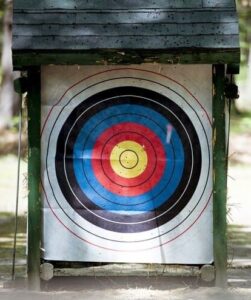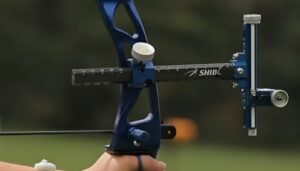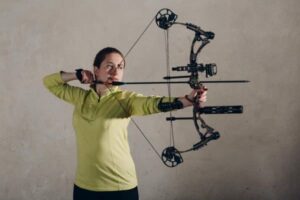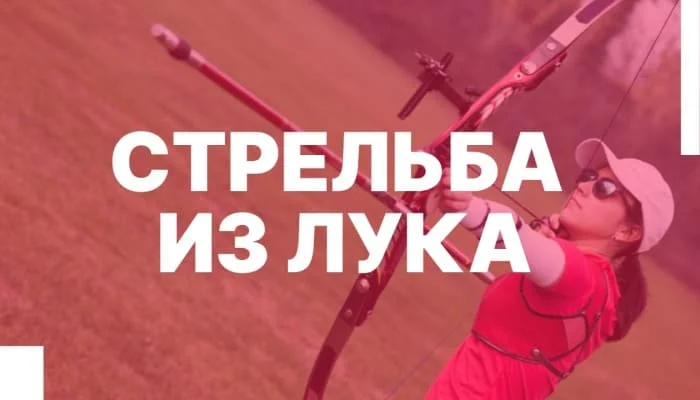In the article “Archery” we will tell you about the accurate shooting of the ancient weapon. You will learn the history of the sport, competition rules, and talk about equipment.
#Archery #SportsBow #OlympicBow #SummerSports
Because archery became a sport so long ago that no one knows exactly who the first archer in history was. The first known archers were the Egyptians, and the Chinese held recreational tournaments as early as 1027 B.C.
Archery as an art form originated 22,000 years ago in South Africa, before nations were formed. In fact, the sport can be considered one of the oldest on earth, as the fundamental fact of spread was effective hunting and participation in battles.

In time firearms began to supplant the bow, and it was used in Europe as a sport among the wealthy. Men placed targets at a certain distance and fired several shots at them. In 1583 the first archery tournament was organized in Great Britain, and in the early 19th century a federation was created.
Archery was first introduced in the Olympics in 1900. The sport was part of the 1904, 1908, and 1920 tournaments. Due to the lack of common rules, archery withdrew from the Olympics for 52 years until 1972.
Archery is a very complex discipline, because in addition to shooting skills you need to use ultramodern equipment. Archery equipment consists of the bow itself, arrows, quiver, release (trigger mechanism) and mitts (hand protection from the bowstring).
Classic competitions are held in individual and team scoring. Each competitor fires a certain number of arrows, and the one who scores the most points wins.
There are fewer rules in archery than in other sports because of the simplicity of the competition. Nevertheless, there are rules that must be strictly adhered to. If an archer breaks them, he will be disqualified.

Safety is the most important rule in archery. You should always aim at the target and wear protective gear. The archer has only 2 minutes for each round of 3 arrows. The archer may not begin shooting until given permission by the judge.
The targets consist of ten rings, which decrease in diameter as they approach the center. The center ring, or “bullseye,” is worth 10 points, and each outer ring is “worth” one point less.
If an arrow hits a line between two rings, the higher number of points is recorded in the score. If an arrow hits another arrow and gets stuck in it, the athlete is recorded as many points as from the arrow in which it got stuck.
After shooting, the archer goes to the target and pulls out his arrows. There can be several rounds within a single competition. In the Olympics, the archer competes in the first round in 12 rounds and fires 6 arrows each (total number of arrows fired = 72). Subsequent rounds (playoffs) involve only 12 arrows each.
In most indoor competitions, the archer participates in 20 approaches, but fires 3 arrows each. Thus, the total number of arrows is 60 and the maximum number of points = 600.
In case of a tie, a tie-break will be awarded. In the tie-break, each competitor fires one arrow until the best shot is determined. Whoever makes it wins the playoff or competition.
Indoor and outdoor competitions differ in the range of the set target and the size of the target itself. Outdoor targets are set at distances of 30 to 90 meters, and indoor targets are set at distances of 18 to 50 meters. At the Olympics, the distance to the target is 70 meters. At the Olympics, the diameter of the target is 122 cm, but indoors it is only 40 cm.

A bow is the archer’s main tool for successful performance in competitions. This weapon is selected and customized for each athlete. The archer’s height, arm length, physical strength, stance and method of shooting are taken into account when selecting the weapon. The archer has to be a true expert in the achievements of the modern archery industry.
The grip is the part to which all the other parts of the bow are attached (see figure, item 2). The athlete’s hand must lie perfectly in the rest, otherwise the muscles will be unnecessarily strained and it will affect the quality of shooting. There are holes in the grip, and they also have their own purposes. They lighten the overall weight, and in the case of windy weather, reduce the resistance of the bow.
Materials used in making the bow include carbon and aluminum. Carbon is much lighter than metal and as strong as metal. Carbon is also used to make stabilizers (see figure, paragraphs 8, 9, 13 and 14), which are rods that diverge in different directions, compensate the impact and give stability to the weapon.
The point is that at the moment of firing, the bowstring strikes the bow and it begins to vibrate. The vibrations are transmitted to all its parts and are felt even in the hand. The bow’s behavior, in this case, is unpredictable, so combating vibration is the number one challenge for manufacturers.

The front sight is a device that allows you to accurately aim your bow at a target. The position of the front sight on the bracket changes depending on the distance to the target.
Modern arrows are also made of carbon. This material allows the arrow to fly more steadily, i.e., it reduces the oscillation. Every professional athlete experimentally chooses all the characteristics of an arrow: length, weight, tip, and feathering. The main thing is that all arrows in the quiver should be strictly the same to the micron and to the milligram, without this a stable hit in the “bullseye” cannot be achieved.
The bowstring has also undergone a technical revolution. The threads from which it is made are uniquely strong and resistant to wear and tear. The string is now made of synthetic fibers and coated with wax, so it is not afraid of moisture and temperature changes.
Ropes are tailored to each athlete, so it is preferred to make their own hands. For this purpose, a special equipment (machine) is used, which connects several threads, makes a winding around the threads, connects them into a single whole.
On the quality of the thread and their quantity depends on what kind of character to get a bowstring. The thinner – the faster, the thicker – the slower. Manufacturers assure that one bowstring will survive 10,000 shots.

In addition to the Olympic bow, there is also the block bow. The main difference from the Olympic type is the presence of special blocks on the shoulders. These blocks distribute the load and allow even the untrained shooter to pull the bowstring to the limit.
The force of tension on the block bow reaches 300 newtons and the speed of an arrow can reach 320 km/hour. Block bows are a type of sport bows, but they do not participate in the Olympics.
Every archer knows that no matter how hard the conditions are, and no matter how perfect the weapon is, you can’t win without an inner attitude. Total concentration and precision of movement in all circumstances are mandatory qualities of a high-class athlete.
And all of this is practiced at daily training sessions at sports schools. You can enroll in the section from the age of 11. The only limitation that will prevent you from becoming an Olympic champion is complicated eye surgery, nearsightedness or farsightedness of extreme degree.
Modern archery places more and more demands on athletes. Not only millimeters, but also seconds. A professional archer simply needs to keep up with the times. The perfect weapon, carbon arrows – you can’t win without these.
Archery. Types of bows and arrows
FAQs
What is archery?
Archery is an Olympic sport in which athletes compete in the accuracy of archery with arrows from 18 to 90 meters. The winner is the one who scores the highest number of points.
What sport does archery belong to?
Archery is developed as an independent and separate sport (Archery). It is managed by the International Olympic and Paralympic Archery Federation (WA, World Archery).
What are the benefits of archery classes?
Archery in general develops almost all muscle groups, but the training focuses on the muscular corset, which has a positive effect on posture. In just a year of training you will become focused, determined and attentive, you will learn to control yourself and your emotions. Shooting sports perfectly develops the eye, respiratory and cardiovascular systems.









